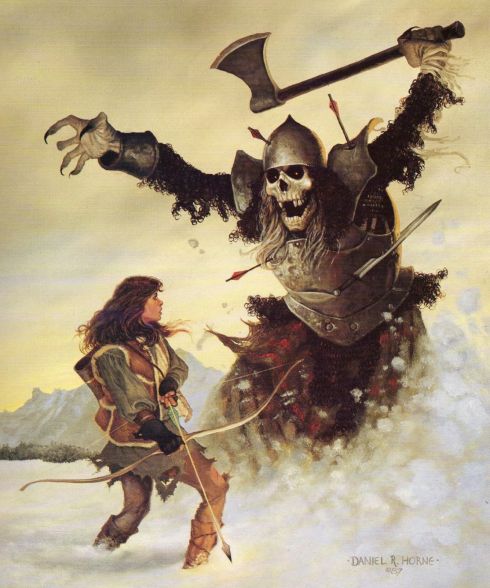Difference between revisions of "Hit Dice"
Tao alexis (talk | contribs) |
Tao alexis (talk | contribs) |
||
| (2 intermediate revisions by the same user not shown) | |||
| Line 1: | Line 1: | ||
| − | Every living creature has an established '''Hit Dice''', | + | [[File:Hit Dice.jpg|right|490px|thumb|More hit dice means more more hit points]] |
| + | Every living creature has an established number of '''Hit Dice''', indicating the creature's relative power. This governs the creature's [[Hit Points|hit points]], ability [[Roll to Hit|to hit]] opponents in [[Combat|combat]] and its [[Saving Throws|saving throw]]. Hit dice are assigned arbitrarily by the campaign, as a means to compare one creature vs. another in power and threat. | ||
| + | |||
| + | Hit dice are obtained through the natural growth and nature of the creature. As hit dice are not the result of training and combat experience, they shouldn't be confused with [[Experience Level|experience levels]]. When a creature gains an experience level, the abilities and hit points from that experience is ADDED to the creature's hit points. | ||
| + | |||
| + | :'''For example''', a mature [[Gnoll|gnoll]], regardless of training, has 2 hit dice, which provide the gnoll with a certain number of hit points depending on [[Hit Points per Die|its mass]]. Once the gnoll is trained to be a "1st level" fighter, it receives an additional d10 hit points from that training. | ||
| + | |||
| + | Hit points are awarded '''per die'''. So, in the example above, a gnoll weighing 280 lbs. gains 1d8 hit point per die, or 2d8 hit points. The size of a creature is not always an indicator of how many hit dice it possesses; a [[Cockatrice|cockatrice]] is much smaller than a [[Crocodile|crocodile]], but it has more hit dice. It also receives less hit points per die than a crocodile receives due to its small size. In general, hit dice are awarded according to a creature's cleverness, malevolence, energy, instincts or supernatural influence. Very large creatures that have these qualities will have many hit dice and many hit points, making them very dangerous. | ||
| − | |||
| − | |||
| − | |||
| − | |||
See also,<br> | See also,<br> | ||
[[Attacking in Combat]]<br> | [[Attacking in Combat]]<br> | ||
| − | [[ | + | [[Monster]]<br> |
| + | [[THAC0]]<br> | ||
| + | |||
| − | [[Category: | + | [[Category: Don't Review until 2022]] |
Latest revision as of 23:45, 20 September 2021
Every living creature has an established number of Hit Dice, indicating the creature's relative power. This governs the creature's hit points, ability to hit opponents in combat and its saving throw. Hit dice are assigned arbitrarily by the campaign, as a means to compare one creature vs. another in power and threat.
Hit dice are obtained through the natural growth and nature of the creature. As hit dice are not the result of training and combat experience, they shouldn't be confused with experience levels. When a creature gains an experience level, the abilities and hit points from that experience is ADDED to the creature's hit points.
- For example, a mature gnoll, regardless of training, has 2 hit dice, which provide the gnoll with a certain number of hit points depending on its mass. Once the gnoll is trained to be a "1st level" fighter, it receives an additional d10 hit points from that training.
Hit points are awarded per die. So, in the example above, a gnoll weighing 280 lbs. gains 1d8 hit point per die, or 2d8 hit points. The size of a creature is not always an indicator of how many hit dice it possesses; a cockatrice is much smaller than a crocodile, but it has more hit dice. It also receives less hit points per die than a crocodile receives due to its small size. In general, hit dice are awarded according to a creature's cleverness, malevolence, energy, instincts or supernatural influence. Very large creatures that have these qualities will have many hit dice and many hit points, making them very dangerous.
See also,
Attacking in Combat
Monster
THAC0
